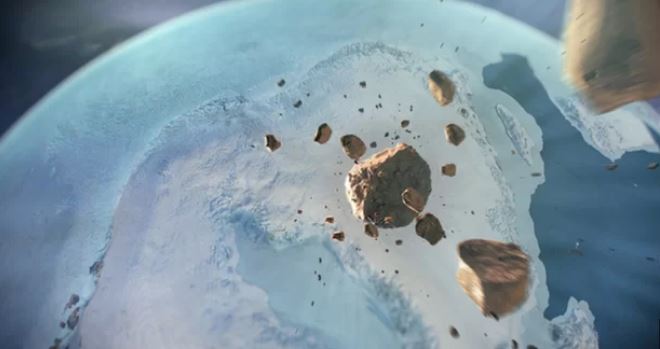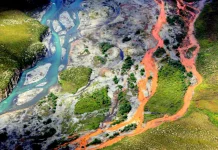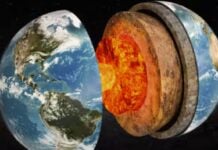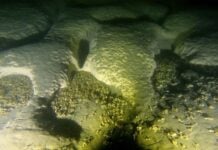Earth hides its scars well; the planet has endured countless millennia of eruptions and collisions, but scientists are still stumbling upon the evidence of all that geologic drama. Now, a giant crater nearly 20 miles (31 kilometers) wide has been discovered one hidden below Greenland’s ice. Scientists believe it was created as a huge iron meteorite slammed into Earth sometime in the past 3 million years. OMG!

The feature in question is tucked below the edge of the ice sheet in northwest Greenland, lending a semicircular edge to the ice sheet near where a glacier called Hiawatha flows toward the sea. Looking through data originally gathered to track changes in the ice itself, scientists spotted a strangely circular feature in the bedrock, so they arranged for a high-powered ice-penetrating radar instrument to fly over the area.
That instrument’s data confirmed the structure of the feature itself: a depression large enough to hold all of Paris in its embrace, with a clearly defined rim all the way around. So, scientists flew in to gather samples in person, looking for chemical fingerprints of an exotic event that could have formed the feature.
And while the glacier blocks the scientists from reaching the heart of the crater, it makes up for that inconvenience by ferrying sediment out from the site in meltwater. “It’s almost like a home delivery,” said Kurt Kjær, lead author of the study and a geologist at the Natural History Museum of Denmark at the University of Copenhagen.
Among those sediments, geologists found what they believe are shocked quartz grains, the result of an impact’s force abruptly melting rock. The team also analyzed the chemistry of the sample, finding an unusual fingerprint of rhodium, platinum and palladium. “We don’t tend to find that in many rocks that we find on Earth,” said Iain McDonald, a geochemist at Cardiff University in the U.K. who conducted that analysis. “I’m pretty convinced by what’s there.”
There’s another twist to the puzzle of the crater
In Kjær’s own institution sits a large iron meteorite that was found about 185 miles (300 km) away from the crater site.

Could it be that the meteorite and crater originated from the same incoming asteroid breaking up in Earth’s atmosphere as it fell to the surface? “I think it’s fair to start speculating if those two are linked,” Kjær said. “Maybe we found the home of this meteorite. That would be fun.”
For Kjær, what’s most exciting isn’t even the dramatic collision or its potential successors — it’s the act of stumbling upon something unknown. “Look here — the age of discovery is not over yet,” he said. “We can still go out here and find things that we didn’t see before.”
Asteroids are a hazard. They are, in fact, a threat to human civilization. We want to better understand the consequences if or when one of those objects actually hits the Earth, and one way to do that is to go into the geological record and measure those impacts.
Follow us on Facebook and Twitter or become a Patron on Patreon / donate through Paypal. Please and thank you
Science – A large impact crater beneath Hiawatha Glacier in northwest Greenland
LiveScience – Paris-Size Crater Found Hidden Under Greenland Ice













I did a presentation for our rock & mineral club last month on this very subject! We’ve been hit A LOT.
You say this crater was formed within the last 3 million years (OMG!) but the Kaali craters in Estonia were formed 7500-7600 years ago and the Tunguska event was only 100 years ago. Just the blink of an eye geologically speaking. Duck and cover?